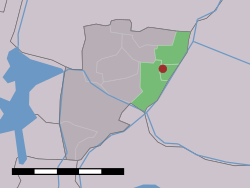De Rijp
De Rijp | |
|---|---|
Village | |
 Drawbridge and Grote Dam (right: the Town hall) | |
 | |
 The village (dark red) and the statistical district (light green) of De Rijp in the former municipality of Graft-De Rijp. | |
| Coordinates: 52°33′25″N 4°50′43″E / 52.55694°N 4.84528°E | |
| Country | Netherlands |
| Province | North Holland |
| Municipality | Alkmaar |
| Population (1 January 2005) | |
| • Total | 4,020 |
| Time zone | UTC+1 (CET) |
| • Summer (DST) | UTC+2 (CEST) |
De Rijp is a village and former island in the Dutch province of North Holland. It is a part of the municipality of Alkmaar, and lies about 10 km northwest of Purmerend, between the Schermer and the Beemster polders. Before the poldering of the lakes surrounding it, De Rijp was famous for its herring industry. Today it is known for its characteristic rijksmonuments, which include some of the oldest wooden houses of North Holland.
De Rijp was a separate municipality until 1970, when it merged with Graft.[1]
The statistical area "De Rijp", which also can include the surrounding countryside, has a population of around 4020.[2]
History

Before the lakes on either side of De Rijp were pumped dry, De Rijp was a port town with merchant ships that travelled the high seas on trade routes. The town had a medium-sized herring fleet, and searched for whales with larger ships. Rijper vessels travelled regularly to Spitsbergen. After the success of the polders near Alkmaar and Egmond, plans were formed to make polders of the other lakes in North Holland, including the ones on both sides of De Rijp. In 1605 De Rijp split off from Graft and became a relief center for the effort to pump the Beemster dry. The project was run by the architect-engineer Jan Leeghwater, who had been born in De Rijp and even designed the Town hall.
The coat of arms of De Rijp show two herrings which symbolize the importance of the fishing industry for the town. The polders meant that the Rijper ships needed to travel much further before they were on open water. The herring industry remained important however and the stained glass window in the Grote Kerk with the city coat of arms of Enkhuizen, donated by the cooper's guild, shows the barrels that were made for use by the herring packers in De Rijp in 1655. The town had suffered a devastating fire in 1654 which wiped out the southern side of the town and destroyed the church, leaving only the north side (including the city hall) intact. The herring ships had been undamaged and it was their industry that enabled the town to rebuild the church. When it was completed in 1655, various guilds such as the coopers, and other towns of North Holland donated stained glass windows with their coats of arms in 1655. These included Medemblik, Alkmaar, Haarlem, Amsterdam, Monnickendam, Edam, Enkhuizen, and Purmerend. This group of stained-glass windows are considered national treasures and were restored in 1993-1995 when safety glass with a fine mesh of metal was installed on the outside of the window frames but left open at the edges to prevent condensation. Similar safety measures have been taken for the stained-glass windows of Gouda.
-
Glass 3 (detail) showing two coopers making barrels
-
Glass 4 (detail) showing the herring fleet
References
- ^ Ad van der Meer and Onno Boonstra, Repertorium van Nederlandse gemeenten, KNAW, 2011.
- ^ Statistics Netherlands (CBS), Statline: Kerncijfers wijken en buurten 2003-2005 Archived 2006-07-24 at WebCite. As of 1 January 2005.
- Glazen Verhalen: de Grote Kerk te De Rijp, edited by Nelly de Goede, Stichting De Rijper Glazen, De Rijp, 2009
External links
- Template:Kuyper Map of the former municipality, around 1868.
- Picture gallery from De Rijp (2007)
- Webcam of the town from the top of the church




